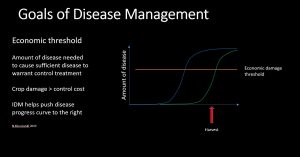Although not widespread in the state, root knot nematodes (RKN) can be problematic for some Illinois producers of field crops and vegetables. There are several species of RKN found in Illinois, but the most important species in the state are Meloidogyne hapla (Northern RKN) and M. incognita (Southern RKN). Differentiating RKN species is very difficult, and specialized tests often need to be conducted to identify the species. As the name implies, southern RKN is found in warmer, southern climates, whereas northern RKN typically is found at higher latitudes. This can be an issue for portions of central Illinois, where conditions could potentially favor both species if they occur. Symptoms of RKN include stunting, chorosis, and wilting of plants, often in patches within a field. Yields can be reduced due to the impact of RKN on the abilities of roots to acquire nutrients and water from soils.
RKN have very wide host ranges and damage crops by injuring roots and causing swellings of the roots, called galls. Galls on soybean root systems can be distinguished from beneficial nitrogen fixing bacterial nodules by breaking open the structure; galls will be colorless to milky white inside, whereas nodules will be pink. In addition, galls are also generally much larger than nodules. Severely affected root systems are often swollen, knotty, and irregular in shape as a result of galling (Figure 1).

RKN overwinter in the soil as eggs. Root exudates from a susceptible host (i.e. soybean) will trigger RKN juveniles to hatch if soil temperature exceeds 50°F. Once hatched, the juveniles locate and penetrate roots, and females establish, become sedentary, and induce gall formation. Galls serve to provide resources directly to the sedentary females, and also provide females protection against environmental stresses. Females eventually lay eggs in a gelatinous matrix outside of the root, which can hatch and reinfect roots or overwinter in the soil. The lifycycle of RKN is typically between 21-28 days, and multiple infection cycles can occur during the season. Reports of lifecycles as short as 14 days long have been reported under conditions highly favorable for RKN growth and reproduction.
Management of RKN starts with documenting problematic fields and identifying problematic areas within these fields. Knotty roots are a easily diagnostic feature of this organism; however, if needed, soil and plant samples can be sent to the UIUC plant diagnostic clinic for analyses. Click here for more information.
Remember that RKN and other soilborne pathogens transmitted to new fields and areas by mechanical equipment and workers. If you have a field with RKN, consider sanitizing equipment after working in the field to reduce the likelihood of transferring the nematode to other locations. As mentioned earlier, RKN have a wide host range and can infect corn and small grains, reducing the utility of rotation as a management option.
There are several RKN resistant materials available for southern RKN in higher maturity groups, and some cultivars have been identified with resistance to northern RKN in lower maturing groups. The next time you decide to plant soybeans in an RKN infested field, consider selecting a cultivar with RKN resistance.
Some types of cover crops can be used managing root-knot nematode. Planting and incorporating a biofumigant-type mustard with high glucosinolate production can potentially fumigate root-knot nematode eggs in the soil and reduce root-knot damage on a subsequent crop, but effectiveness varies with species and cultivar. Utilization of mustards requires additional management as the crop must be flail chopped approximately 2 weeks before bloom and immediately tilled into soils to maximize biofumigation potential. In addition, irrigation or rain should follow incorporation to help the biofumigation process and seal the soil surface. Some mustard species are hosts for RKN, so root-knot populations could actually increase if the biofumigation crop fails or is not properly incorporated.
Additional cover crops have been bred for nematode management. Some of the oilseed-type radishes are not hosts for RKN but have the ability to induce egg hatch. As the hatched nematodes will not have a host to feed on, they eventually starve to death, hopefully before the cash crop is planted. Research on the effectiveness and utility of various cover crops for RKN management are ongoing in several research labs across the United States.
Lastly, there are several seed treatments available that have the potential to reduce initial populations of nematodes. Research has shown that the utility of these products is highly variable. Remember that RKN and other pathogenic nematodes can reproduce and infect throughout the season, whereas seed treatments will protect newly emerged and developing plants within the first weeks planting. Therefore, any reduction of RKN at the onset of the season may not be sufficient to reduce populations below levels that cause yield reduction over the course of crop development.
Be mindful that none of the management practices mentioned are not silver bullets, and each can contribute to reducing RKN populations. Utilizing multiple management strategies will provide the greatest reduction of RKN populations and yield improvement the next time soybeans are planted into affected fields.

